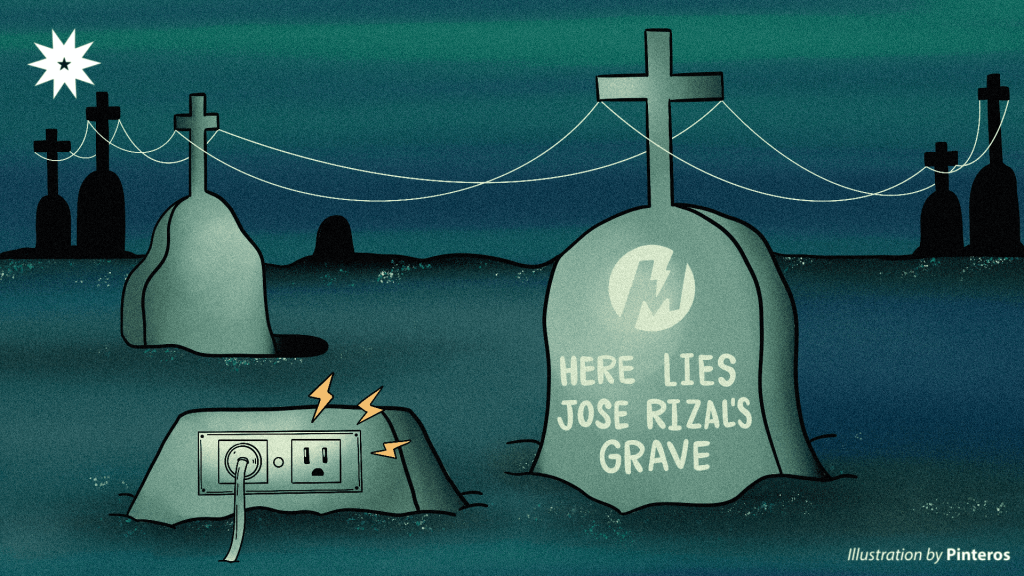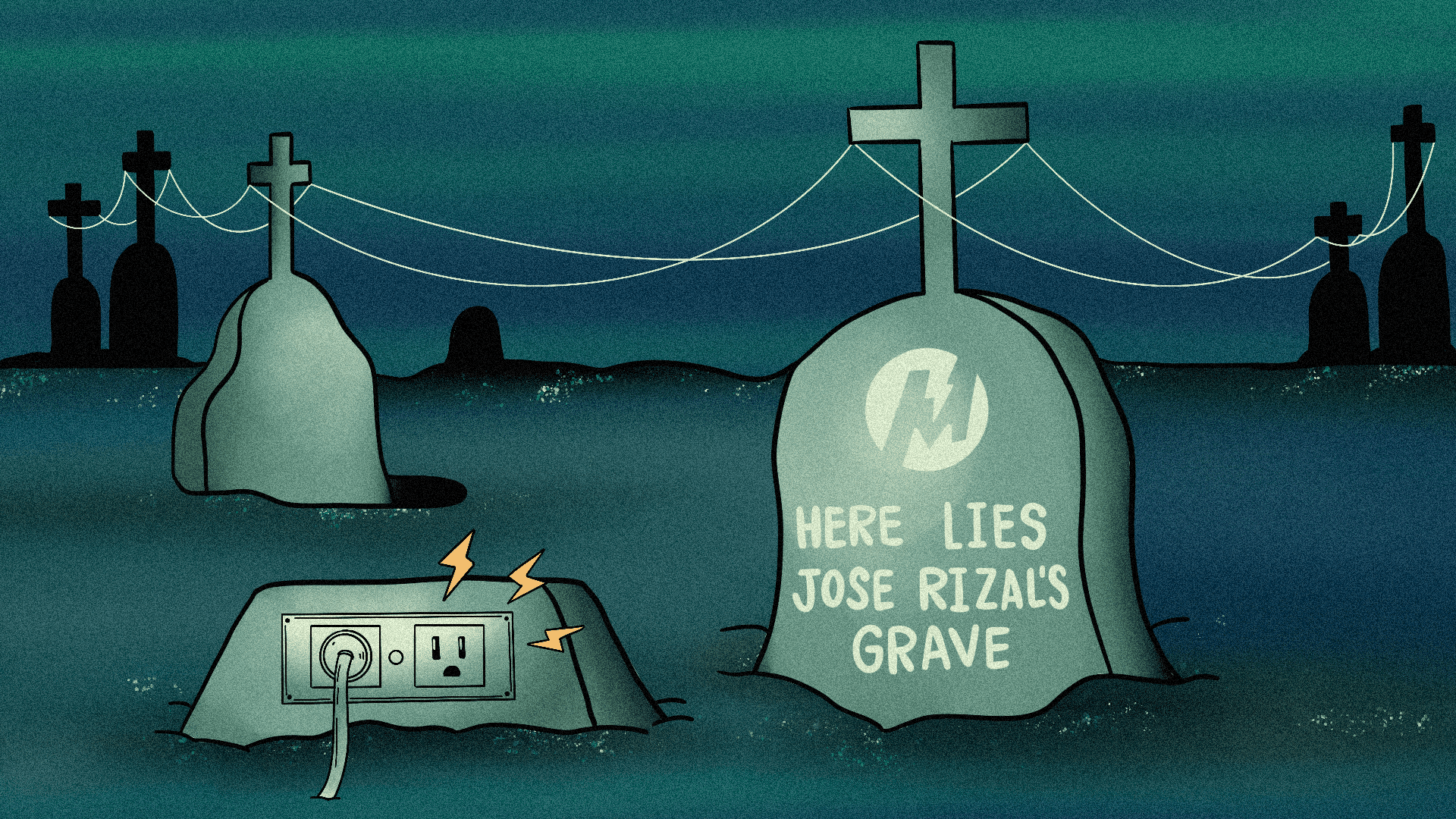For eons, mankind has searched far and wide for a source of energy that is efficient, readily available, and environmentally friendly to breathe life into the technologies that form the pillars of society—lights, telephones, the internet, and much more. What matches our limited lifespan, however, is the limited resources of our earth.
As we continue to roll toward an energy crisis amid our ever-growing demand for electricity, Dr. Frank N. Stein believes the solution to this conundrum may be found in the undying energy of those who have long left us.

‘Dead easy to harness’
While working as a professional gravedigger, Stein first discovered corpse-powered energy when he unearthed the tomb of José Rizal in search of the mythical Tallano gold. But instead of a river of gold, he found a rolling corpse, which started to spin faster once the distinctive scent of Manila Bay started seeping into the tomb, and the resulting burst of energy electrocuted him. This case caught Meralco’s attention.
In a press release statement following the incident, Meralco announced that they have investigated the rolling of Rizal’s corpse in a bid to help alleviate the perpetual scarcity of electricity in the Philippines. The company discovered that the energy produced by the rolling corpse can be harvested and turned into electricity. Earlier this year, Meralco unveiled its killer plan to construct the nation’s first corpse-powered power plant (CPPP) in José Rizal’s tomb, continuing his dream of liberating the Filipino people—from high energy prices.
“Corpse-powered energy is dead easy to harness—the only thing you need is a generator,” says Dr. Julius Strangelove, the head of the nation’s corpse-powered energy program. He compares the operation of a CPPP to a wind turbine; much like how the wind spins the blades of a turbine, a rolling corpse can be used to power a generator.
With the end of the casket attached to a generator’s rotor, the mechanical energy produced by the rolling corpse will be converted into electricity, which will be distributed to consumers. According to Strangelove, the energy harnessed from the corpse is sustainable and extremely efficient. No harmful emissions are released into the atmosphere because it does not rely on burning fuel. Moreover, Stranglelove claims that as much as 95 percent of the energy produced by the corpse can be converted into electricity—the only thing being wasted is the nation’s potential.
Rolling in the deep
Based on simulations, the CPPP produced around 3,100 megawatts (MW) of power when President Bongbong Marcos won the 2022 elections. The power plant normally outputs around 300 MWs, which was barely enough to power the speaker’s blasting out Andrew Espiritu’s UniTeam jingle 24/7 during the campaign period. Meralco’s head engineer for the CPPP states, “The Rizal CPPP increases its output every time something nationally relevant happens, and this allows us to predict energy spikes and adjust electricity prices accordingly.”
A few hours after Marcos won, Meralco logged another massive spike in energy when multiple movie stars and television personalities nabbed seats in the Philippine Senate. At the time, Rizal produced a whopping 4,000 MWs of energy. Lim recalls, “He was spinning so rapidly that the area around his grave shook.” He theorizes that Rizal was looking forward to the action, drama, and bravado that these celebrities brought to the government. “Rizal wrote Noli Me Tangere, which was full of action and suspenseful moments. Maybe he was finally proud that Robin Padilla brought the same essence into the Senate floor,” Lim posits.
Even though Meralco can anticipate how the CPPP will operate, their prediction model is not infallible. “We expected huge energy outputs when KathNiel broke up because the entire nation was grieving, but Rizal didn’t move at all,” Lim adds. “Perhaps he was more excited for the second coming of the infamous golden era of the Marcos family.”
Moreover, the return of the Villar family to the Senate also made Rizal spin like the wheels of a bicycle going down a steep hill. “Rizal is most likely homesick, so the thought of Rizal Park being turned into a Spanish-themed Camella subdivision really must have thrilled him,” Lim concludes.
The true potential can really be affirmed by these numbers. After all, many average nuclear, coal, and fuel plants typically only have an energy output in the hundreds of MW. Some of the more expensive and cutting-edge nuclear reactors can achieve up to 10,000 to 20,000 MW of power. If Rizal’s corpse alone is capable of producing a gross energy output of over a thousand MW, then the potential of “rolling over” from our usual energy sources to corpse-based energy is massive.
Worth the rot
Still reeling from his initial incident with Rizal’s corpse, Stein has emerged from St. Luke’s Cremation Center and is now quite the celebrity. Aside from attending talk shows and interviews, Stein is now the undersecretary of the Department of Grave Digging and Corpse Maintenance (DGD-CM) as well as chairperson of the Union of Grave Diggers.
“Indeed, the DGD-CM is perhaps now the most important agency when it comes to our energy sector,” boasts Stein. “I mean, I don’t really get what reactors and [MW] are supposed to mean, but it seems like they’re pretty important.”
With massive funding siphoned from the now-downsized Department of Energy (DOE), the ambitious Stein is planning on not just capitalizing on the rolling corpses of notable people but also converting old cemeteries into what he calls the “rolling energy farms.”
“I mean, there’s probably a lot of disappointed ancestors who are currently rolling due to their disappointing kids, grandkids, and great-grandkids,” Stein comments. “Sure, individually, they may not match Rizal’s record of over 4,000 MW, but who knows? And with the hundreds of corpses of ancestors, the output could be high!”
For now, Strangelove is motioning for scholarships and research grants for studies related to power-generating corpses. There still needs to be some standardization in the methods and ethics of the procedures. As per current observations, it does seem the rotational velocity and, therefore, the energy of the corpse depends on the morality and worldview of the person—while they were still alive, of course. Depending on our internal characteristics, Strangelove is optimistic that we can one day be rolling ourselves to a brighter future.
This article was published in The LaSallian‘s Spoof 2024 issue. To read more, visit bit.ly/TLSSpoof2024.



